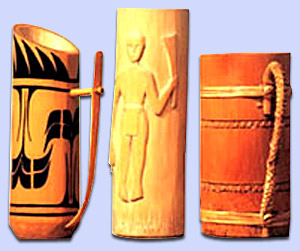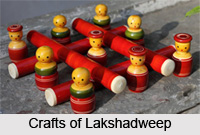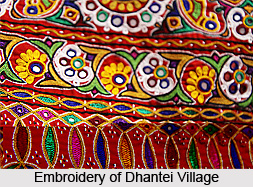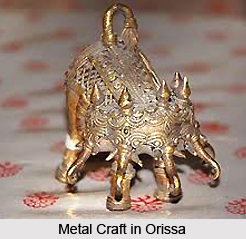 Metal Craft in East India deals with the Indian states like West Bengal, Orissa, and the adjacent areas. Metal craft in East India is well known for the skilful conception and the manufacture from various metals like brass, copper, gold, silver and some alloys.
Metal Craft in East India deals with the Indian states like West Bengal, Orissa, and the adjacent areas. Metal craft in East India is well known for the skilful conception and the manufacture from various metals like brass, copper, gold, silver and some alloys.
Metal Crafts of West Bengal
Metal craft of West Bengal is well recognised for the proficient creations from various metals like brass, copper, gold, silver and some alloys. The design and ethnicity of the metal crafts has been maintaining the tradition of the ancient India with an amalgamation of modern trends.
Art of making metal craft of West Bengal has been handed down to the present artisans from the past craftsmen who were adept at creating exclusive items since the prehistoric ages. The metal crafts of West Bengal offer an array of items that range from utilitarian items to traditional jewelleries that are done with chisel work and sometimes `Meenakari` work.
Artisans of Bankura, Bishnupur, Ghatal and Chandanpur in Midnapore, are engaged in engraved brass and bell metal work. In addition to this, one of the well appraised forms of metal craft of West Bengal is Dhokra craft which is perhaps the only living tradition of metal image making in Eastern India. This form of craft is named after a tribe and this tribal art is recognised in the present market because of its distinctive style and the wide ranges of items it offers. Dhokra Kamar tribe, however, includes the Malhars of Jharkhand and Sithrias of Orissa (metal craftsmen) as well. The West Bengal metal workers, known as the Dhokras and the Dheppons inhabit the districts of Bankura, Midnapore, Purulia, Birbhum and Burdwan.
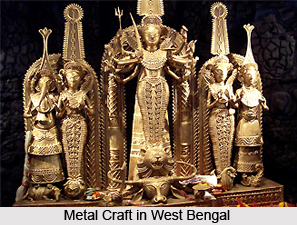 The metal craft of West Bengal includes the superb creations of Dhokra craft that include payeri or mol (anklets), hansuli (necklace), earrings and bangles. Besides these, some of the knick knacks made by these artisans are the Buli (piggybank), measuring bowls or paikona of different sizes, a ceremonial finial pot kalas, which is mounted on a wooden pole for festivals. In addition to these items, the artisans create various kinds of ritualistic objects that have immense importance in Hindu religion. images and figures of gods and goddesses, birds and animals, like Lakshmi, Lakshmi-Narayan, pancha pradeep, Siva-Parvati flanked by Ganesh and Kartik, elephants, horses, owls, peacocks etc. Moreover, the Dokras of Netkamla and Bindhyajan are known for creating household items and various jewelleries that are worn by the local tribal women. The people of this community sometimes go to the fairs and markets to sell their creations and thus promoting the art form.
The metal craft of West Bengal includes the superb creations of Dhokra craft that include payeri or mol (anklets), hansuli (necklace), earrings and bangles. Besides these, some of the knick knacks made by these artisans are the Buli (piggybank), measuring bowls or paikona of different sizes, a ceremonial finial pot kalas, which is mounted on a wooden pole for festivals. In addition to these items, the artisans create various kinds of ritualistic objects that have immense importance in Hindu religion. images and figures of gods and goddesses, birds and animals, like Lakshmi, Lakshmi-Narayan, pancha pradeep, Siva-Parvati flanked by Ganesh and Kartik, elephants, horses, owls, peacocks etc. Moreover, the Dokras of Netkamla and Bindhyajan are known for creating household items and various jewelleries that are worn by the local tribal women. The people of this community sometimes go to the fairs and markets to sell their creations and thus promoting the art form.
The metal craft of West Bengal is highly acclaimed because of its rich cultural heritage that has given the craft a different dimension in the history of Indian metal craft. Though the ancient tradition has instances of heavy metal work, the contemporary trend has altered the style and with the fusion of tradition and style different jewelleries are created. Apart from them, the metal craft in present time involves creating different items that are extensively used in home d‚cor. Moreover, simple and sleek designs are favoured in contemporary times.
Metal Crafts of Orissa
Metal craft of Orissa can be featured with the socio cultural aspect of the state in association with the tradition. The shrines and the temples are the examples of rich cultural heritage of the state with standard materials.
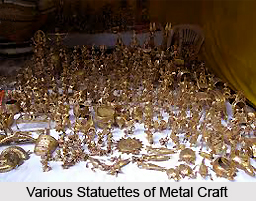 Metal craft of Orissa includes the usage of metals like Brass and Bell metals and the people of Kansari community mainly create different items out of them. Castings of brass items are practiced by the people of Ganjam. The motifs used in the decorative pieces are mainly inspired from the folk culture of Orissa. The artisans use an alloy of copper and zinc and of copper and tin to give shape to different items. Apart from the usage of brass and bell metals the artisans of Orissa are adept at creating jewelleries and items with silver and gold. Cuttack is famous in the entire world for the unique and delicate craft of `tarkashi` or well known as the silver filigree work. This art of creating items is considered one of the intricate works by the artisans who create splendid jewelleries with a touch of tradition.
Metal craft of Orissa includes the usage of metals like Brass and Bell metals and the people of Kansari community mainly create different items out of them. Castings of brass items are practiced by the people of Ganjam. The motifs used in the decorative pieces are mainly inspired from the folk culture of Orissa. The artisans use an alloy of copper and zinc and of copper and tin to give shape to different items. Apart from the usage of brass and bell metals the artisans of Orissa are adept at creating jewelleries and items with silver and gold. Cuttack is famous in the entire world for the unique and delicate craft of `tarkashi` or well known as the silver filigree work. This art of creating items is considered one of the intricate works by the artisans who create splendid jewelleries with a touch of tradition.
The metal craft of Orissa has been flourishing at Puri, which is the abode of skilled craftsmen who specialise in minute metal work. Moreover, places such as Behrampur and Belguntha (in Ganjam district), Tarva (Bolangir district), Chandanpur, Phulbani, and Kantilo are well known for their specialization in producing a variety of brass and bell metal craft objects, which exhibit extraordinary craftsmanship. In Tarva, the craftsmen fashion beautiful utilitarian and decorative objects such as plates, ashtrays and bells out of white metal. A particular variety of metal craft known as `dhokra` is practiced by the `sithulias` who use scraps of metals to make the `dhokra` castings.
The items produced by the beating process are many and the designs also vary from place to place. The `Manjira` or `gini`, two circular cupped convex discs tied to strings and used for beating the rhythm and the `Ghunguroo` or ankle bells tied in the feet of dancers during the festival. Kuliana in Mayurbhanj district, Kaimatin in Keonjhar district, Sadeiberni in Dhenkanal district and Haradagaria in Puri district are well admired for their superiority in Dhokra craft.
The metal craft of Orissa has socio-cultural links and according to the traditions of the state, the bride is presented with a set of brass and bell metal articles for starting off her new home. However, in all major temples almost invariably the moving image or the `Chalanti Pratima` of the presiding deities is made of brass. Among the major icons, the large brass image of Radha in the `Sakhigopal temple` in Puri district , images in temples in Ganjam district, Krishna, Radha, Lord Ganesha, Gurundi Gopal and Lakshmi idols are created with the brass metal. The artisans generally create items based on the motifs of human heads, kings, `Manas` or miniature replica of measures; other items include containers with lids, with or without locking devices, candle stands, ashtrays, pen stands, bowls, plates, spoons, glass, tumbler, bells, thali (plates), handi, baltis (buckets), gina (tumblers), pots and pans, ladles or `Chatu`, perforated flat cooking spoons etc. Even items like the brass fish and snakes are made by the craftsmen of Belguntha in Ganjam district.
Apart from creating household items and items for worship, the metal craft of Orissa include items that are hugely favoured for home d‚cor. Even people who flock to the market of the state prefer to buy exquisitely designed bronze bangles and lamp stands that define exclusive style and standard of the artisans among whom some have been practicing this art form for generations.



